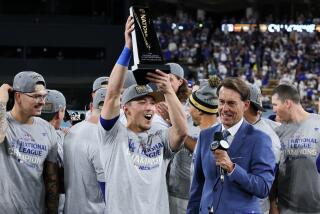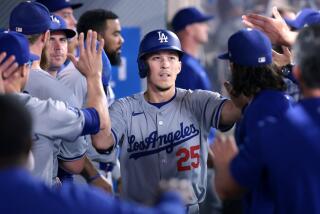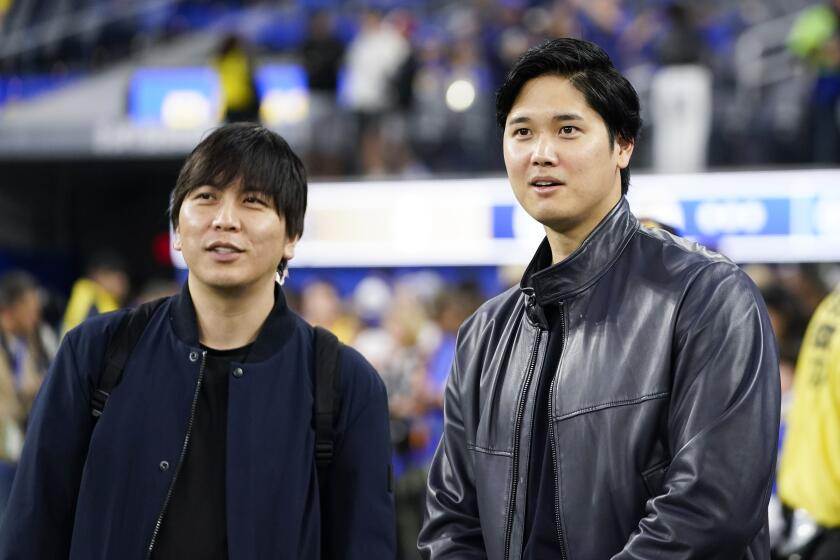Angels Still Look Down on Edmonds
NEW YORK — It is six months later, and the clock may be ticking down on Jim Edmonds’ MVP-caliber debut with the St. Louis Cardinals, who face elimination from the National League’s championship series before the weekend is over.
A sore knee and the New York Mets’ stifling southpaws have Edmonds struggling some, but that does not detract from a season that has left people perplexed, asking:
* What were those reasons again that the Angels traded a player of his talent?
* Couldn’t he have had a season of this magnitude in Anaheim?
* Didn’t the Angels get taken, obtaining only second baseman Adam Kennedy and pitcher Kent Bottenfield, who failed to sustain his 18-victory form of 1999 and was subsequently traded for Ron Gant, another dud?
Simple questions with complex answers.
As complex, perhaps, as Edmonds himself and his often eye-of-the-storm tenure in Anaheim.
His six full seasons with the Angels were often marred by injury and/or strained relations with teammates who openly questioned his intensity, fortitude and priorities, suggesting he wasn’t making full use of his talent.
With the Cardinals this year, Edmonds had career highs for homers, 42, and runs batted in, 108, and then led the division series sweep of the Atlanta Braves while batting .571 and setting series records for doubles and extra-base hits.
“I don’t think he could have had a year of this type in Anaheim,” said Bill Bavasi, former Angel general manager. “I think he was sick of the place and had been drained emotionally. It was a bad environment for him and I think [new General Manager Bill Stoneman] made the right move by trading him.
“I also don’t think it’s safe to say that Jim has turned a corner, that he’ll do this again next year. He’s too unpredictable, although he has a strong group of peers there to keep him straight and focused. Our problem was that we just couldn’t keep him channeled in the right direction.”
Was Edmonds drained emotionally and sick of the place?
Agent Paul Cohen disputed that, saying that as happy as Edmonds is with the Cardinals, who signed him to a six-year, $57-million extension in May, his objective was to re-sign with the Angels last winter but they never made an offer.
“I think that once the Angels began dangling Jim as the trophy for a No. 1 pitcher, it was clear what their intentions were,” Cohen said.
“Now you can see some of the same things starting with Tim Salmon and Mo Vaughn.”
Edmonds was eligible for free agency after the 2000 season, and finances played a role in the trade, Stoneman acknowledged.
He didn’t want the Edmonds situation being a distraction during the season, felt he could most easily and economically re-sign Garret Anderson, and needed to fill two holes by trading his only tradeable commodity, a fourth outfielder.
“We knew that if Jim was healthy, he would have a hell of a year, whether if was with us or elsewhere,” Stoneman said. “We also had four outfielders and needed help at two positions. The fact that Bottenfield didn’t have the year he had in ’99 was a disappointment, but at the time Ken Hill was our only veteran pitcher.
“You give and you get. We got a pretty good year out of a second baseman who figures to be here for a long time and I can’t let Edmonds’ year cloud what we have here.
“I also knew Jim’s [contract] demands would be greater than Garret’s, and I felt Garret definitely wanted to stay, was healthy and had played virtually every day of his career, unlike Jim, who wasn’t always healthy and didn’t always play. Garret is also younger than Jim, and it looked like his power numbers were trending upward and had a real chance to become a major run producer.”
Anderson did just that, setting career highs with 35 homers and 117 RBIs while batting .286.
He was not the Gold Glove center fielder Edmonds is, but this was his first full season at the position and he definitely had a comparable year offensively.
Said Manager Mike Scioscia, “We knew that we wouldn’t be able to make up for what Edmonds might do offensively and defensively, but we had a paramount need for a starting pitcher and second baseman. I don’t know if you can ever get enough for a player of Jim’s talent, but we had the luxury of a fourth outfielder and he was the piece we needed to use.
“There were also other considerations. Would we be able to sign him? Could we count on his durability?”
Both Scioscia and Stoneman, new to the Angels, insist that in familiarizing themselves with an organization wracked by clubhouse turmoil in 1999 they heard no finger pointing at Edmonds or any one person and it would be inaccurate to attach any problems Edmonds might have had with teammates or management with the decision to trade him.
“That simply was not a motivating factor,” Stoneman said. “The only question people raised about Jim was his durability.”
Edmonds played 133 games on bad knees in 1997, batting .291 with 26 homers and 80 RBIs and came back in 1998 to play 154 games, hitting 25 homers with 91 RBIs. Shoulder surgery limited him to 55 games last year, and he never matched his 1995 numbers of 33 homers and 107 RBIs in 141 games.
Durability, however, wasn’t the only question.
At times during his Angel career, he was accused of giving away at-bats through a lack of focus, or not caring. Minor league managers cited his demeanor and body language between pitches as that of a guy uninterested in his job, a guy who should be released, and Bavasi had to tell them repeatedly to watch only what he does between the lines.
“In my tenure with the Angels, Jim was the best player to come out of the system since Devon White,” Bavasi said. “He plays hard, but he has that kind of loosey-goosey, happy-go-lucky appearance, and a lot of guys don’t want to see happy-go-lucky. Some guys are simply more intense. I mean, it’s tough to characterize, but the same people who would be attacking him one day would be defending him the next.”
Former Angel infielder Dave Hollins was among his most vocal clubhouse critics, sources said, but their careers have definitely moved in different directions since then. Perhaps, said Cohen, part of the problem in Anaheim stemmed from envy.
Two incidents seemed to characterize clubhouse emotions:
* Edmonds was the focal point of Angel frustration after their elimination from the 1998 race during the final week in Oakland--accused of not being upset about it, not caring--even though he had been the only Angel to perform well down the stretch, batting .340 with 20 RBIs in September.
“Jim smiles a lot and is outgoing--that’s his persona--but you can’t act like that when you’re on the verge of elimination,” shortstop Gary DiSarcina said at the time. “You can’t bounce into the clubhouse without a care in the world when your teammates are bloodied, ticked off and not wanting to lose.”
* While lifting weights in late March of last year, Edmonds tore ligaments in his non-throwing shoulder and was basically sidelined for the season by surgery.
He acknowledged that his shoulder had been hurting for several years, which left angry teammates wondering why he was lifting weights and why he hadn’t had the surgery in October so he would have been ready for spring training and available to the Angels during that tumultuous year.
“I blame myself for some of that,” Bavasi said. “I blame myself for not bearing down on our medical staff and not having them bear down on Jim to have gotten that taken care of. I also blame Jim for not recognizing his responsibility to the club and himself. The one thing about Jim is that he’s never going to be shortchanged in life. He has his jet skis at the lake and he’s going to have his fun. He brought on some of the problems himself.”
Cohen bristled.
“I don’t see how anyone can say he brought things on himself,” the agent said. “Look at his stats. Look what he did in crunch time. Look at his defense every year. He played hard and he played hurt. He made highlight films diving to make catches.
“People who say that he should have had the shoulder surgery earlier are ignorant of the facts. The Angels and the medical people were aware of the condition for several years, but their attitude was that as long as he was hitting his 25 to 30 homers a year and driving in 90 to 100 runs, they’d leave it alone.”
Cohen added that if Edmonds didn’t work hard and didn’t care about winning, why did he build a gym in the basement of his new St. Louis house and why does he have a clause in his contract allowing him to opt out after three years if the Cardinals don’t maintain a payroll among the top 15 clubs?
If he is all about money, Cohen asked, why did he accept a Cardinal contract at less than market value and reject the opportunity to become a free agent next month?
Cardinal General Manager Walt Jocketty said they investigated Edmonds and came away convinced that “a lot of things had been blown out of proportion with the Angels.
“We felt Jim would have an opportunity in our environment, with the manager and coaching staff and the type players we have, to benefit from a new start--and that is exactly what has happened,” Jocketty added.
Edmonds reiterated last week that he is happy to be removed from the bickering and jealousy of the Angel clubhouse he knew. He said the Cardinals are a true team, the best group of guys he has ever played with, and that St. Louis fan support is even better than he had heard or imagined.
“I was pretty much the convenient target in Anaheim and that was unfair,” he added. “I also think some members of the L.A. media contributed to the problem by blowing things out of proportion.”
The trade was made on March 23. Half a year later, an obviously motivated Edmonds--”There is no question but that he’s trying to show his critics they were wrong,” Cohen said--has turned it into a steal for the Cardinals.
Some might suggest that it would never have come to a trade if he had been as obviously motivated in Anaheim.
More to Read
Go beyond the scoreboard
Get the latest on L.A.'s teams in the daily Sports Report newsletter.
You may occasionally receive promotional content from the Los Angeles Times.






